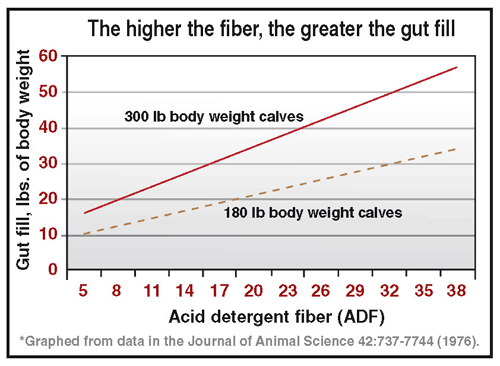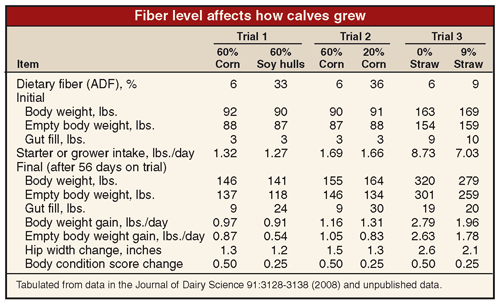The authors are with Akey Nutrition and Research Center, Lewisburg, Ohio.

Feeding high-starch starter and grower feeds support the most daily gain.
A common mistake that is made is to begin feeding roughage too soon after weaning.
There is an expression "you are what you eat." This is true for calves.
Calves are unique animals that change from a single-stomach to multi-stomach ruminant. At birth, the rumen is very small - maybe the size of a baseball at best - and nothing more than a "pouch" in the digestive tract. It has no digestive function . . . yet. If fed a high-starch diet that is optimum for rumen development and growth, the rumen will be about the size of a basketball by 6 weeks of age near weaning time. If all goes well, its volume grows to be similar to a beach ball by 12 weeks of age. Diet and management affect this development. If the diet is too low in starch, rumen development and growth are slowed.
Calves are babies . . .
As calf caretakers, we sometimes overlook that calves are babies. They are, in fact, more like a human baby or piglet than their dam. Feeding high-starch starter and grower feeds supports the most daily gain. Several studies dating back to the 1950s have demonstrated this very clearly. However, sometimes there are studies that suggest that calves gain body weight with diets containing fiber. These studies can be confusing to scientists, feed industry personnel, and calf feeders. Let's dig into the data over the years to get clarity.
Researchers at Virginia Tech in the 1970s fed diets with various concentrations of nutrients and reported that fiber can impact "real" body weight gain drastically. Let's define the terms. "Real" body weight gain sometimes is called empty body weight gain. Total body weight is measured by simply weighing a calf. This total weight consists of empty body weight and gut fill. Gut fill is the water and feed residue in the digestive tract.
Total weight misleading . . .
In the Virginia Tech research, at a common protein intake, gut fill became greater, and empty body weight gain became less as acid detergent fiber (ADF) was raised in the diet. To help visualize this in 180- and 300-pound body weight calves, the amount of gut fill is plotted in the figure relative to the concentration of ADF in the diet. Note the dramatic rises in gut fill as dietary ADF went up. So simply weighing a calf may not tell the real story. When diets of different fiber concentrations and types are compared, researchers must attempt to correct for gut fill to determine the "real" weight and weight gain of the calves.
The table shows the total body weights, gut fill, and empty body weights of calves fed diets with different amounts and types of fiber. In Trial 1, 60 percent corn (high starch, low fiber) or 60 percent soybean hull (low starch, high fiber) pelleted diets were fed to calves less than 2 months old. Performance of the calves was greatly reduced with high-soy-hull diets relative to high corn diets.
In Trial 2, similar diets high in soy hulls (20 percent corn) supported considerably less body weight gain in calves over 3 months of age compared to diets high in corn (60 percent corn). The diet with 20 percent corn also contained wheat midds, soy hulls, alfalfa meal, corn gluten meal, beet pulp, and cottonseed hulls which raised the fiber content of the diet.
Also, in Trial 2, calves fed the low- corn diet gained the most total body weight, but they had 21 pounds more gut fill. Thus, their empty body weight gain was much less than calves fed the high-corn diet.

The young calf does not have enzymes to digest fiber, and calves do not have a large enough and established microbial population to ferment fiber. Feeding bulky feeds like hays, straws, silages, and haylages takes up rumen space and displaces space for grains and proteins that can be digested. A common mistake that is made is to begin feeding roughage too soon after weaning. A 3-month-old calf does not have the rumen capacity or digestive capability via rumen microbes to utilize diets with free-choice hay or large amounts of fibrous feeds like soybean hulls, wheat midds, cottonseed hull, and corn gluten feed. This sometimes is very evident in the change in appearance of calves at weaning and 3 or 4 weeks postweaning. Often calves at weaning appear to have good body condition, a barrel-like gut, and a smooth hair coat. These calves were fed milk or milk replacer and starter. They are moved to a group pen with other calves, and the starter or grower feed is restricted to about 5 pounds daily, and hay or forage is offered free-choice. Thus, a calf becomes what it eats. The calf begins to lose body condition, its hair coat begins to look rough, and it develops a "hay belly." Energy intake has been restricted with this high- hay diet to the point that even frame development is reduced.
Feeding calves a high-grain diet with limited high-quality forage after weaning allows for rapid weight gain and frame development. In the trials mentioned above, frame growth paralleled weight gain, but in no trial did the calves gain excessive body condition.
Treat calves more like piglets up to 4 months of age. Feed them a diet high in corn that is not restricted. Do not feed hay until 2 months of age. Feed only a high-quality, leafy forage from 2 to 4 months of age, and limit the amount of forage to no more than 10 percent of the diet, preferably 5 percent. This amounts to about 0.3 to 0.6 pound of hay daily from 2 to 4 months of age.

Click here to return to the Calf & Heifer E-Sources
090510_344

A common mistake that is made is to begin feeding roughage too soon after weaning.
There is an expression "you are what you eat." This is true for calves.
Calves are unique animals that change from a single-stomach to multi-stomach ruminant. At birth, the rumen is very small - maybe the size of a baseball at best - and nothing more than a "pouch" in the digestive tract. It has no digestive function . . . yet. If fed a high-starch diet that is optimum for rumen development and growth, the rumen will be about the size of a basketball by 6 weeks of age near weaning time. If all goes well, its volume grows to be similar to a beach ball by 12 weeks of age. Diet and management affect this development. If the diet is too low in starch, rumen development and growth are slowed.
Calves are babies . . .
As calf caretakers, we sometimes overlook that calves are babies. They are, in fact, more like a human baby or piglet than their dam. Feeding high-starch starter and grower feeds supports the most daily gain. Several studies dating back to the 1950s have demonstrated this very clearly. However, sometimes there are studies that suggest that calves gain body weight with diets containing fiber. These studies can be confusing to scientists, feed industry personnel, and calf feeders. Let's dig into the data over the years to get clarity.
Researchers at Virginia Tech in the 1970s fed diets with various concentrations of nutrients and reported that fiber can impact "real" body weight gain drastically. Let's define the terms. "Real" body weight gain sometimes is called empty body weight gain. Total body weight is measured by simply weighing a calf. This total weight consists of empty body weight and gut fill. Gut fill is the water and feed residue in the digestive tract.
Total weight misleading . . .
In the Virginia Tech research, at a common protein intake, gut fill became greater, and empty body weight gain became less as acid detergent fiber (ADF) was raised in the diet. To help visualize this in 180- and 300-pound body weight calves, the amount of gut fill is plotted in the figure relative to the concentration of ADF in the diet. Note the dramatic rises in gut fill as dietary ADF went up. So simply weighing a calf may not tell the real story. When diets of different fiber concentrations and types are compared, researchers must attempt to correct for gut fill to determine the "real" weight and weight gain of the calves.
The table shows the total body weights, gut fill, and empty body weights of calves fed diets with different amounts and types of fiber. In Trial 1, 60 percent corn (high starch, low fiber) or 60 percent soybean hull (low starch, high fiber) pelleted diets were fed to calves less than 2 months old. Performance of the calves was greatly reduced with high-soy-hull diets relative to high corn diets.
In Trial 2, similar diets high in soy hulls (20 percent corn) supported considerably less body weight gain in calves over 3 months of age compared to diets high in corn (60 percent corn). The diet with 20 percent corn also contained wheat midds, soy hulls, alfalfa meal, corn gluten meal, beet pulp, and cottonseed hulls which raised the fiber content of the diet.
Also, in Trial 2, calves fed the low- corn diet gained the most total body weight, but they had 21 pounds more gut fill. Thus, their empty body weight gain was much less than calves fed the high-corn diet.

The young calf does not have enzymes to digest fiber, and calves do not have a large enough and established microbial population to ferment fiber. Feeding bulky feeds like hays, straws, silages, and haylages takes up rumen space and displaces space for grains and proteins that can be digested. A common mistake that is made is to begin feeding roughage too soon after weaning. A 3-month-old calf does not have the rumen capacity or digestive capability via rumen microbes to utilize diets with free-choice hay or large amounts of fibrous feeds like soybean hulls, wheat midds, cottonseed hull, and corn gluten feed. This sometimes is very evident in the change in appearance of calves at weaning and 3 or 4 weeks postweaning. Often calves at weaning appear to have good body condition, a barrel-like gut, and a smooth hair coat. These calves were fed milk or milk replacer and starter. They are moved to a group pen with other calves, and the starter or grower feed is restricted to about 5 pounds daily, and hay or forage is offered free-choice. Thus, a calf becomes what it eats. The calf begins to lose body condition, its hair coat begins to look rough, and it develops a "hay belly." Energy intake has been restricted with this high- hay diet to the point that even frame development is reduced.
Feeding calves a high-grain diet with limited high-quality forage after weaning allows for rapid weight gain and frame development. In the trials mentioned above, frame growth paralleled weight gain, but in no trial did the calves gain excessive body condition.
Treat calves more like piglets up to 4 months of age. Feed them a diet high in corn that is not restricted. Do not feed hay until 2 months of age. Feed only a high-quality, leafy forage from 2 to 4 months of age, and limit the amount of forage to no more than 10 percent of the diet, preferably 5 percent. This amounts to about 0.3 to 0.6 pound of hay daily from 2 to 4 months of age.

090510_344








